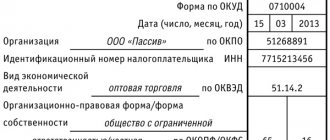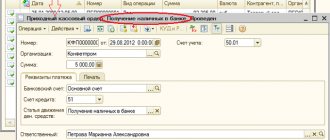Information about the company’s activities for the reporting period is accumulated in the forms of approved accounting (financial) reports (Order of the Ministry of Finance of Russia dated July 2, 2010 No. 66n, as amended on April 19, 2019). Thus, the “Cash Flow Statement”, which is an appendix to the enterprise’s balance sheet and deciphers the data of its line 1250, informs the user about the volume of receipts and cash expenses incurred for the period of time under consideration. It provides complete information on the movement of money in the context of current, investment and financial activities. However, it is customary to display some data in collapsed form. For example, information about revenues that characterize not the actual work of the enterprise, but rather the activities of its partners. The list of cash flows, the volume of which should be indicated in a collapsed manner, is presented in paragraph PBU 23/2011. It also includes VAT, since this tax is contained in the structure of receipts from buyers or payments of various kinds, including to the budget, as well as reimbursement from the budget. Let's talk about how VAT is recorded in the “Cash Flow Statement” (CFDS).
What options are there to show VAT?
The amounts received and paid by the company to counterparties must be calculated without taking into account the amount of tax before they are reflected as VAT in the cash flow statement. The difficulty of calculating without VAT is that the fee is included in the payment indicators.
In accounting, it is not always possible to reflect the deposit and receipt of amounts including VAT in accounts separately. Accountants calculate revenue figures without the amount of the fee using a special algorithm.
First, the turnover amounts for debit accounts 60, 62, 76 are taken with the correspondence of credit accounts 51, 50. The resulting values are multiplied by the tariff. The calculated rate can be 10/110 or 20/120 if the VAT rate is 10 and 20%, respectively. The indicator that remains after highlighting the value will be called the “cleared from collection” amount of receipts.
There are some calculation nuances if different types of company services are taxed at different rates. In this case, the accounting employee needs to divide the receipts according to the appropriate tariffs and separately allocate and clear the collection by product category. To make the calculation simpler, you can open different sub-accounts.
According to current regulations, you cannot choose the option of submitting the fee to the DDS. If, for some circumstances, isolating and clearing deductions is impossible, this fact should be reflected in the clarifications to the ODDS.
Stage 4. We calculate the NPV and cash balances at the end of the period
The difference between planned inflows and outflows will determine the NPV, which is also calculated in the context of the three types of operations. The total net flow value is then calculated as the sum of the partial ones. Add it to the initial balance from the first stage - you will receive money at the end of the budgeting period.
An important technical point: start planning with current operations, then move on to investment ones, and end with financial ones. This is so because the money deficit is most often closed by attracting loans and borrowings. They relate to financial receipts. To understand whether there is a need for them and, if so, to what extent, first determine what operating and investment activities together provide.
For an example of BDDS articles, which was formed by the direct method, see the diagram. Also download it in Excel spreadsheet format.
Figure 5. Structure of BDDS by direct method: example
VAT movement: shown separately and collapsed
All receipts into the company and amounts transferred by the counterparty must be cleared of the tax indicator before filling out the cash flow statement. This situation can cause difficulties for accountants, since in accounting, payments and fees are not always reflected separately in the account.
In this regard, some use a calculation method for clearing revenue from VAT. To do this, the amounts of turnover on accounts DT 60, 62, 76, CT 51, 50 are taken. The resulting value is multiplied by the calculated rate.
If there are transactions taxed at a rate of 20% and 10%, then the calculation process becomes more complicated. To determine the indicator without collection by calculation, flows are divided into operations with different tariffs. The fee is also cleared from the amount of own payments. Payments are displayed in ODDS without deductions, flows are collapsed. If it is not possible to isolate VAT flows, this must be indicated in special explanations.
“Input” VAT and balance sheet.
Line 1220 “Value added tax on acquired assets”
Information about current assets in the form of VAT, which is subsequently subject to deduction, is reflected in the balance sheet1 (clause 5, 20 PBU 4/99 “Accounting statements of an organization”2
). For these purposes, a special line is provided here - 1220 “Value added tax on acquired assets.”
By purchasing material assets (works, services), property rights, their buyer “receives” VAT (of course, if the seller is a payer of this tax). The “input” tax is determined in account 19 “Value added tax on acquired assets” and can subsequently be accepted (again, by the VAT payer) for deduction (in accounting this is reflected by posting Debit 68-VAT Credit 193). But to acquire the right to a tax deduction, you must comply with certain articles. 171 and 172 of the Tax Code of the Russian Federation conditions:
- the purpose of the purchase for activities subject to VAT;
- capitalization of the acquisition;
- availability of an invoice issued by the counterparty in accordance with Art. 169 of the Tax Code of the Russian Federation.
If acquired material assets (work performed, services provided) will be used in activities not subject to VAT, the “input” VAT on them is written off to cost accounts or included in the cost of the property.
Thus, it is quite likely that there is no balance on account 19 on the last day of the reporting period. Then line 1220 “Value added tax on acquired assets” is not filled in (a dash is placed in it).
But if you, for example, carry out export operations (which means you accept VAT for deduction only after confirmation of the fact of export), produce goods in a long cycle (you accept tax on purchases necessary for production for deduction only after the shipment of such goods to the final buyer), you play the role tax agent for VAT (tax is deducted after the “live” transfer of funds to the budget), simply did not receive an invoice from the counterparty (other stories are possible), the balance on account 19 is inevitable. That is, line 1220 in the balance sheet will have a numerical value.
Note. If data on the amounts of VAT subject to deduction for certain types of acquired assets is essential for the organization and is necessary for the formation of a reliable and complete picture of the financial position of the organization among interested users, it can detail the amounts of “input” VAT ( clauses 6, 11 PBU 4/99 ) - for example, according to lines 12201 “VAT on acquired fixed assets”, 12202 “VAT on acquired inventories”, etc.
Self check
You can check how accurately the VAT amount is taken into account in the report yourself. To do this, you need to pay attention to line 4119. To carry out the check, a special formula is used to establish the final flow.
To calculate the final flow, you need to subtract the fees paid to suppliers and payments to the budget from the tax amounts received from the buyer. The amount of the returned fee is added to the received value.
What does "reflect collapsed" mean?
This term implies separating separately the amounts of VAT tax from the amount of cash flows both paid and received. The amounts should be grouped as follows:
- the amount of funds received from the sale of products from clients, customers, buyers;
- the amount of money that was paid for goods, services and other work;
- amounts of tax payable to the budget;
- tax amounts that are subject to refund from the budget.
It is necessary to highlight only those values and payments that the company claims for deductions to the budget. Otherwise, no allocation is required.
An example of reflecting VAT in the ODDS
To understand how to show VAT in a document, it is recommended that you familiarize yourself with the example. For example, there is a limited liability company "Grand". The amount of tax contributions received from buyers amounted to 2000 units. The amount of contributions transferred to suppliers is 500 units. An amount of 200 units was allocated to the budget. The amount of receipts is calculated as (2000 – 500 – 200) = 1300 units.
It is reflected on page 4119. There is a certain methodology for calculating the indicator on page 4121 of payments to suppliers. You need to add up the revolutions. Afterwards, the amount of the fee - payments to suppliers - is subtracted.
If data on sales of non-current assets is entered in line 4121, data from accounts 50-52 are added in correspondence with account 62 for indicators from the sale of fixed assets. Tax is subtracted from the resulting figure.
Before entering data in line 4221 of payments in connection with the acquisition of non-current assets, you need to add momentum. The calculation takes into account the amounts that were paid for fixed assets. The fee is removed from the result obtained.
How to collapse amounts in a report?
There are situations when the amount of cash flows must be shown collapsed in the report. For example, such cash flows are specified in clause 16 of PBU 23/2011. These amounts include VAT.
In order to reflect the tax amounts collapsed, you must perform the following actions shown in the table.
| Amounts | Name | Order |
| VAT amounts received from buyers and customers | VAT received | Reflect without VAT values the amounts of receipts from customers in the line “receipts from the sale of products, goods, works and services (code 4111) |
| Amounts that went to post office workers | VAT paid | Without VAT value, reflect payments to suppliers using line code 4121 |
| VAT amounts paid to the budget | VAT payable to the budget | |
| VAT amounts refunded from the budget | VAT refundable from the budget |
Important! Only those tax amounts that are subsequently claimed by the company for deduction in accordance with Chapter 21 of the Tax Code of the Russian Federation are subject to allocation.
An example of a blank and completed ODDS report form in 2021 is presented in the attachments.
ODDS blank form
ODDS completed form
Example of filling out the ODDS
There are some peculiarities in filling out the document; questions often arise about how to calculate payments and where they need to be displayed. First, you need to fill in cash flow indicators from current operations, payments and receipts. Payments are displayed for product sales, rental fees, resales, and other income.
The payments include compensation to employees, interest on debts, income taxes and other payments. If there is no indicator, a dash is added.
BDDS is
BDDS is one of three financial budgets. Besides this there is also:
- budget of income and expenses (BDR). Read more about him in the article “BDR”
- balance budget.
The BDDS reflects planned receipts and payments, and also calculates net cash flow (NCF). Together with money balances, the latter shows either a surplus or deficit in the money supply.
The main purpose of compiling a BDDS is to manage the solvency of the company. Particular tasks follow from it:
- justification of the need to attract and calculation of the amount of additional financial resources (borrowed funds);
- awareness of the irrationality of the current conditions of settlements with counterparties and their subsequent adjustment;
- creating an information basis for plan-fact analysis of cash flows and searching for reasons for the discrepancy between the forecast and reality.
Most common mistakes
One of the common shortcomings is the incorrect display of VAT amounts in the report, especially if parentheses are not added. For example, if the amount is negative, it is shown in brackets in the report.
Another common mistake is the incorrect reflection of the monetary amount of VAT payable. If, when determining the tax, the value has a plus sign, it is indicated in a special order in the report.
BDDS by indirect method: form and example
Here we also highlight four stages.
Stage 1. We take the financial result as a basis - net profit or loss
This is the final line of the BDR. It summarizes income and expenses for all business operations of the enterprise. This is where the first problem of using the indirect method begins. After all, we need to differentiate flows into three types of activities. It is logical that the financial result should be divided in a similar way.
With the operational component, everything is simple. It calculates profit (loss) from sales separately. But, as a rule, no one does a separation of the results in terms of investment and financial transactions in the BDR. What should I do? There are at least two options:
- make additional calculations, isolating from other income and expenses those that fall under investment and those that fall under financial. If analytics is well organized and/or there are few such operations, then this is a short process;
- don't count anything. At the same time, proceed from the assumption that net profit (loss) is the result exclusively of operating activities. The accuracy of calculating NPV by group will suffer, but it will save time.
Stage 2. We remove the influence of non-monetary income and expenses
In the table from the beginning of the article we provided a list of such components. Highlight them as part of the BDR or using operating budgets. Then adjust your net profit/loss as follows:
- add non-cash expenses;
- Subtract non-cash income.
This will eliminate their impact on the financial result and make it closer in value to the NPV.
Form 4 of financial statements: cash flow statement
There are some features of reflecting VAT (value added) in the ODDS. This report (Form 4) shows the structure of the flow of flow from the organization's activities. The form is a financial report that displays data for the reporting period. This form is not interim reporting.
The document was approved in Form 4 by order of the Ministry of Finance of the Russian Federation. It is compiled according to the rules. The base in it includes receipts from revenue and expenditure for all types of operations. The values in the documentation are displayed in rubles. When money is received in a different currency, the indicators are recalculated at the Central Bank exchange rate at the time of receipt of contributions.
BDDS: how to compile by direct and indirect methods
There are two approaches to forming a BDDS:
- straight.
Based on the plan for income and expenses from the financial statement, as well as taking into account the peculiarities of settlements with counterparties, the organization calculates future receipts and payments;
- indirect.
The basis is the forecast financial result, as well as changes in assets and liabilities from the balance sheet budget. By adjusting the former by the values of the latter, the NPV is found. Then the planned cash balances are calculated.
Let's take a closer look at both approaches.
How to create indicators
To fill out the report, take data on debit and credit turnover for accounts 50 “Cash”, 51 “Current account”, 52 “Currency accounts”, 55 “Special bank accounts”, 57 “Transfers in transit”. For more information on how cash flow statement indicators are generated, see the table.
An example of how to determine the result of cash flow from current activities
In 2015, the amount of revenue (including advances) received to the current account and cash desk of Alpha LLC amounted to RUB 11,800,000. (including VAT – RUB 1,800,000). During the same period, the organization transferred from the current account payment for goods (work, services) supplied in the amount of RUB 5,900,000. (including VAT – RUB 900,000).
Salaries actually paid to employees in 2015 amounted to RUB 2,000,000.
The amount of funds allocated for other expenses is 100,000 rubles. The budget includes income tax - 500,000 rubles, VAT - 700,000 rubles, insurance contributions to extra-budgetary funds - 680,000 rubles.
Thus, the difference between the VAT amounts received from partners as part of revenues (as well as from the budget) and the tax amounts transferred to counterparties as part of payments (as well as to the budget) amounted to 200,000 rubles. (RUB 1,800,000 – RUB 900,000 – RUB 700,000). This amount is indicated in the line “Other income”.
On the line “Other payments” the accountant indicated the amount of 780,000 rubles, which adds up:
- from funds allocated for other expenses (RUB 100,000);
- from insurance contributions to extra-budgetary funds (RUB 680,000).
The cash flow report for 2015 in terms of the formation of the section “Cash flows from current operations” was compiled by the Alpha accountant as follows (thousand rubles).
| Title of report articles | Line codes | For 2015 |
| Receipts – total | 4110 | 10 200 |
| including: from the sale of products, goods, works and services | 4111 | 10 000 |
| from rent payments, license fees, royalties, commissions and other similar payments | 4112 | – |
| from resale of financial investments | 4113 | _ |
| other supply | 4119 | 200 |
| Payments – total | 4120 | (8280) |
| including: suppliers (contractors) for raw materials, materials, works, services | 4121 | (5000) |
| in connection with the remuneration of employees | 4122 | (2000) |
| interest on debt obligations | 4123 | – |
| corporate income tax | 4124 | (500) |
| other payments | 4129 | (780) |
| Balance of cash flows from current operations | 4100 | 1920 |
An example of how to determine the result of cash flow from investing activities
In 2015, Alpha LLC paid for the purchased premises worth RUB 5,000,000. In the same year, Alpha provided another organization with a cash loan in the amount of 400,000 rubles.
Alpha LLC had no income from investment activities.
In the section “Cash flows from investment operations” of the cash flow report for 2015, the Alpha accountant indicated (thousand rubles):
- on line 4221 “Including in connection with the acquisition, creation, modernization, reconstruction and preparation for use of non-current assets” - (5000);
- on line 4223 “In connection with the acquisition of debt securities (rights to claim funds from other persons), provision of loans to other persons” – (400);
- on line 4220 “Payments – total” – (5400);
- on line 4200 “Balance of cash flows from investment operations” – (5400).
An example of how to determine the result of cash flows from financing activities
In 2015, Alpha LLC repaid a previously received interest-free cash loan in the amount of RUB 500,000.
Alpha LLC had no income from financial activities.
In the section “Cash flows from financial operations” of the cash flow report for 2015, the Alpha accountant indicated (thousand rubles):
- on line 4323 “In connection with the repayment (redemption) of bills and other securities, repayment of loans and borrowings” - (500);
- on line 4320 “Payments – total” – (500);
- on line 4300 “Balance of cash flows from financial transactions” – (500).
Situation: is it necessary to include the balance of account 57 “Transfers in transit” in the amount of the indicator “Balance of cash and cash equivalents at the beginning (end) of the reporting period” of the cash flow statement?
Yes need.
In general, account 57 “Transfers in transit” takes into account funds transferred (transferred) for crediting to the organization’s current account, but not yet credited for their intended purpose. And these are those assets (money) that are essentially already the property of the organization. The balance of account 57 at the beginning and end of the reporting year is reflected in the Balance Sheet on line 1250 “Cash”. In this case, the cash balances reflected in the report must correspond to the indicators of the Balance Sheet (see the rules for filling out the Balance Sheet). Thus, include the balance on account 57 in the report in the amount of cash balances at the beginning and end of the reporting year.
Application and meaning of ODDS
A report on the movement of money within an organization is one of the key management reports that can be easily obtained in almost any form of accounting. It contains information about the company's sources of money itself and its use over time.
The report reflects, directly or indirectly, all, or, in any case, known cash receipts into the company, classifying them according to their sources, and cash expenses (in other words, write-offs) indicating the areas of use within an identical period.
As a financial tool for the manager of an organization, reporting on the movement of money makes it possible from different angles, based on specific values, to analyze the production picture, liquidity, creditworthiness, in a word, to conduct a deep financial analysis of the company based on facts.
Not only internal users of the organization access the factor report data on the movement of funds. The scope of its application is much wider: it is indispensable for external auditors or other interested parties, for example, investors, who with its help can obtain reliable information about the real volumes of expenses and income that the business of a given enterprise generates.
Reasoning on the scale of business as a multidisciplinary activity, we can conclude that the report data reflecting the movement of the company’s money contains the following information:
- Sources of company income by areas;
- Items and classification of expenses, as well as volumes of outgoing expenses;
- The company's financial performance as the ratio of incoming money (income) and outgoing money (expenses), where the former exceed the latter;
- The stability of the company and its ability to fulfill its obligations;
- Accounting data indicating the sufficiency or insufficiency of the financial resources necessary to carry out the business;
- Investment data in terms of ability to invest from own sources.
Figure 1. Sources of ODDS.









